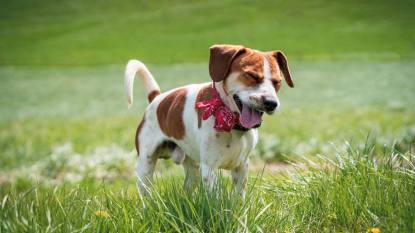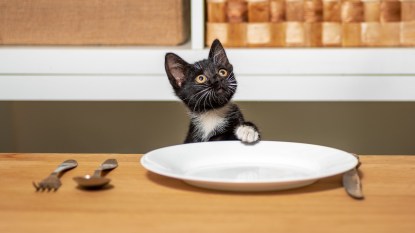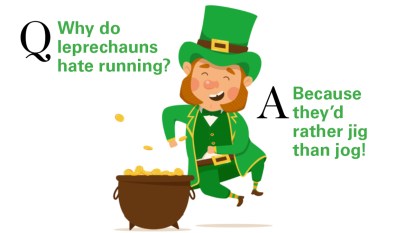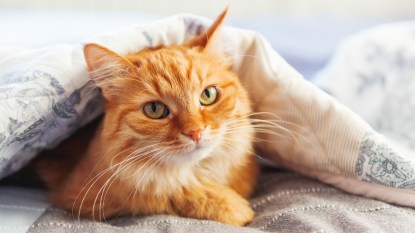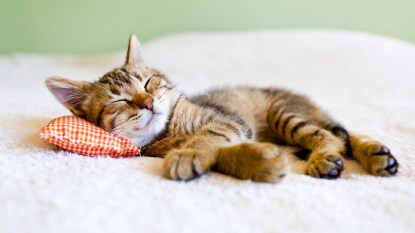What Makes Cats Do the ‘Halloween Cat’ Pose? The Answer Is Frighteningly Simple
Learn how and why cats embrace their spooky side.
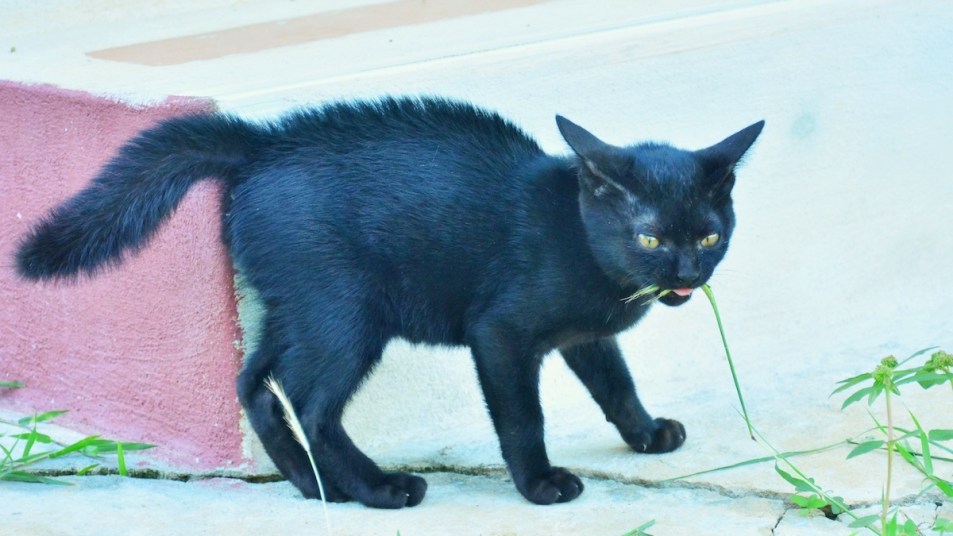
If you have a cat, you probably already know your furry friend is capable of some strange behavior. From knocking cups off your countertops with reckless abandon to zooming around the house at 3 a.m., feline activities are often downright bizarre. But one of the quirkiest (and sometimes most alarming) things they do is make the “Halloween cat” pose: arched back, bristling fur, stiff tail. What does this mysterious pose mean, anyway? We spoke to pet experts to find out.
What is the “Halloween cat” pose?
You’ve seen this classic Halloween decoration pasted on windows and walls: a black cat, often beside a witch, stands with its back arched and fur on end. The image has been a spooky holiday staple for a long time, and it’s based on cats’ real-life behavior: This pose indicates a phenomenon known as piloerection, a temporary raising of the hairs not unlike goosebumps in humans.
The coloring of the creatures you typically see in Halloween decor is driven by historical superstitions surrounding black cats, says Dr. Audrey Wystrach, a North Carolina-based veterinarian and founder and CEO of the vet clinic Petfolk. “In the Middle Ages, people started to associate cats with witchcraft,” she explains. “In folklore, black cats were believed to be able to change into humans and act as spies. When Europeans settled in America, they brought many superstitions with them, including those about cats.”
Some Americans may not believe these superstitions anymore, but others still associate black cats with bad luck. “This superstition is so ingrained in our culture that black cats are less likely to be adopted from shelters,” Dr. Wystrach points out. Since the longstanding connection between these kitties and spooky legend remains part of the holiday, Dr. Wystrach suggests we feline lovers use Halloween as an opportunity to “celebrate black cats” as much as possible.
Why do cats do the “Halloween” pose?
Fittingly, the Halloween cat pose is often associated with fear. “This is a way for a cat to make itself look bigger and more adversarial when confronted with danger,” says Dr. Wystrach. “When a cat feels threatened, it will assume this ‘bigger’ appearance to ward off any threats… the ‘puffed up’ appearance is first and foremost a defense mechanism.” It makes sense that this primal urge to look intimidating would remain part of cats’ instincts, even though any cat owner will tell you the pose can sometimes be downright adorable. (I may have some personal bias, as my own black cat does this quite frequently, and it never fails to entertain).
However, if you see your cat suddenly curving its body like it’s practicing yoga, there’s no need to panic: In some cases, the Halloween cat pose is actually a sign of playfulness. “It’s quite common to see kittens hopping around in and out of the pose, using it to propel themselves from jump to jump,” says Dr. Sabrina Kong, a veterinarian based in California. “Adult cats that have very playful personalities also repeat this behavior.” (Want more cute cat facts? Click through to learn about their sweet, squishy paw pads, or their “toe beans.”)
Should I be concerned if my cat does it?
If your cat’s going Halloween mode, how can you tell if they’re genuinely scared or just goofing around? “Kittens will often do a Halloween pose when they’re playing a chase game,” notes Dr. Chyrle Bonk, an Idaho-based veterinarian and consultant for the site ExcitedCats.com. “During play, the pose won’t be accompanied by hissing or growling.”
Dr. Wystrach also points out that when cats are scared, they show their teeth and push back their ears. Contrastingly, if they’re playful, they’re more likely to bounce back and forth, inviting their owners to run after them. If your cat is reacting fearfully while in the Halloween pose, the cause may be anything from a loud noise, to a sudden change in the environment, to the presence of a perceived enemy (like a dog). Avoid playing with them if you hear any hissing or see any bared teeth.
As for how you should handle an aggressive cat, the pet food brand Hill’s suggests identifying the source of aggression and trying to address it if possible, attempting to distract your cat by redirecting their attention to a toy, and making sure you avoid punishment. Many pets have their occasional mean moment — but if your cat is consistently combative, it may be worth taking them to the vet to make sure there’s not an underlying health issue causing them to act out. (Click through to see why your cat may be licking your hair, too.)
So, the next time your cat assumes this distinctive and seasonally appropriate position, keep an eye out for any signs of aggression. If they just seem to be bouncing along and fluffed-up without any warning sounds or bared teeth, there’s a good chance they’re simply having fun.


